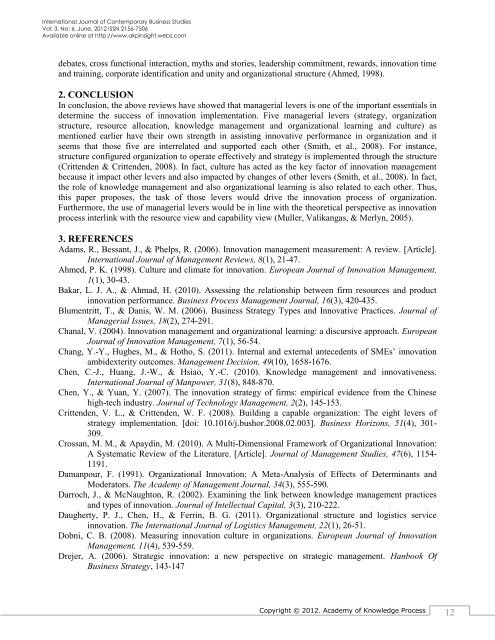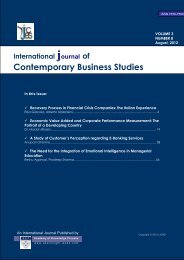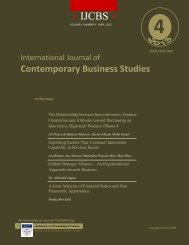International journal of Contemporary Business Studies
International journal of Contemporary Business Studies
International journal of Contemporary Business Studies
You also want an ePaper? Increase the reach of your titles
YUMPU automatically turns print PDFs into web optimized ePapers that Google loves.
<strong>International</strong> Journal <strong>of</strong> <strong>Contemporary</strong> <strong>Business</strong> <strong>Studies</strong><br />
Vol: 3, No: 6. June, 2012 ISSN 2156-7506<br />
Available online at http://www.akpinsight.webs.com<br />
debates, cross functional interaction, myths and stories, leadership commitment, rewards, innovation time<br />
and training, corporate identification and unity and organizational structure (Ahmed, 1998).<br />
2. CONCLUSION<br />
In conclusion, the above reviews have showed that managerial levers is one <strong>of</strong> the important essentials in<br />
determine the success <strong>of</strong> innovation implementation. Five managerial levers (strategy, organization<br />
structure, resource allocation, knowledge management and organizational learning and culture) as<br />
mentioned earlier have their own strength in assisting innovative performance in organization and it<br />
seems that those five are interrelated and supported each other (Smith, et al., 2008). For instance,<br />
structure configured organization to operate effectively and strategy is implemented through the structure<br />
(Crittenden & Crittenden, 2008). In fact, culture has acted as the key factor <strong>of</strong> innovation management<br />
because it impact other levers and also impacted by changes <strong>of</strong> other levers (Smith, et al., 2008). In fact,<br />
the role <strong>of</strong> knowledge management and also organizational learning is also related to each other. Thus,<br />
this paper proposes, the task <strong>of</strong> those levers would drive the innovation process <strong>of</strong> organization.<br />
Furthermore, the use <strong>of</strong> managerial levers would be in line with the theoretical perspective as innovation<br />
process interlink with the resource view and capability view (Muller, Valikangas, & Merlyn, 2005).<br />
3. REFERENCES<br />
Adams, R., Bessant, J., & Phelps, R. (2006). Innovation management measurement: A review. [Article].<br />
<strong>International</strong> Journal <strong>of</strong> Management Reviews, 8(1), 21-47.<br />
Ahmed, P. K. (1998). Culture and climate for innovation. European Journal <strong>of</strong> Innovation Management,<br />
1(1), 30-43.<br />
Bakar, L. J. A., & Ahmad, H. (2010). Assessing the relationship between firm resources and product<br />
innovation performance. <strong>Business</strong> Process Management Journal, 16(3), 420-435.<br />
Blumentritt, T., & Danis, W. M. (2006). <strong>Business</strong> Strategy Types and Innovative Practices. Journal <strong>of</strong><br />
Managerial Issues, 18(2), 274-291.<br />
Chanal, V. (2004). Innovation management and organizational learning: a discursive approach. European<br />
Journal <strong>of</strong> Innovation Management, 7(1), 56-54.<br />
Chang, Y.-Y., Hughes, M., & Hotho, S. (2011). Internal and external antecedents <strong>of</strong> SMEs‟ innovation<br />
ambidexterity outcomes. Management Decision, 49(10), 1658-1676.<br />
Chen, C.-J., Huang, J.-W., & Hsiao, Y.-C. (2010). Knowledge management and innovativeness.<br />
<strong>International</strong> Journal <strong>of</strong> Manpower, 31(8), 848-870.<br />
Chen, Y., & Yuan, Y. (2007). The innovation strategy <strong>of</strong> firms: empirical evidence from the Chinese<br />
high-tech industry. Journal <strong>of</strong> Technology Management, 2(2), 145-153.<br />
Crittenden, V. L., & Crittenden, W. F. (2008). Building a capable organization: The eight levers <strong>of</strong><br />
strategy implementation. [doi: 10.1016/j.bushor.2008.02.003]. <strong>Business</strong> Horizons, 51(4), 301-<br />
309.<br />
Crossan, M. M., & Apaydin, M. (2010). A Multi-Dimensional Framework <strong>of</strong> Organizational Innovation:<br />
A Systematic Review <strong>of</strong> the Literature. [Article]. Journal <strong>of</strong> Management <strong>Studies</strong>, 47(6), 1154-<br />
1191.<br />
Damanpour, F. (1991). Organizational Innovation: A Meta-Analysis <strong>of</strong> Effects <strong>of</strong> Determinants and<br />
Moderators. The Academy <strong>of</strong> Management Journal, 34(3), 555-590.<br />
Darroch, J., & McNaughton, R. (2002). Examining the link between knowledge management practices<br />
and types <strong>of</strong> innovation. Journal <strong>of</strong> Intellectual Capital, 3(3), 210-222.<br />
Daugherty, P. J., Chen, H., & Ferrin, B. G. (2011). Organizational structure and logistics service<br />
innovation. The <strong>International</strong> Journal <strong>of</strong> Logistics Management, 22(1), 26-51.<br />
Dobni, C. B. (2008). Measuring innovation culture in organizations. European Journal <strong>of</strong> Innovation<br />
Management, 11(4), 539-559.<br />
Drejer, A. (2006). Strategic innovation: a new perspective on strategic management. Hanbook Of<br />
<strong>Business</strong> Strategy, 143-147<br />
Copyright © 2012. Academy <strong>of</strong> Knowledge Process<br />
12
















